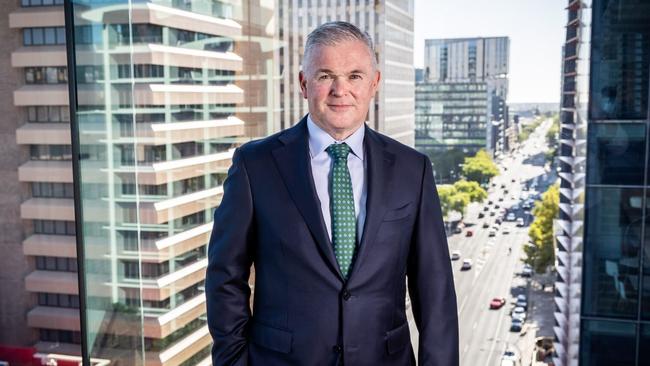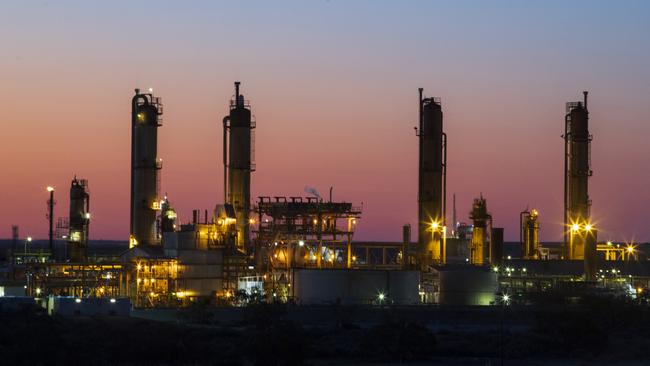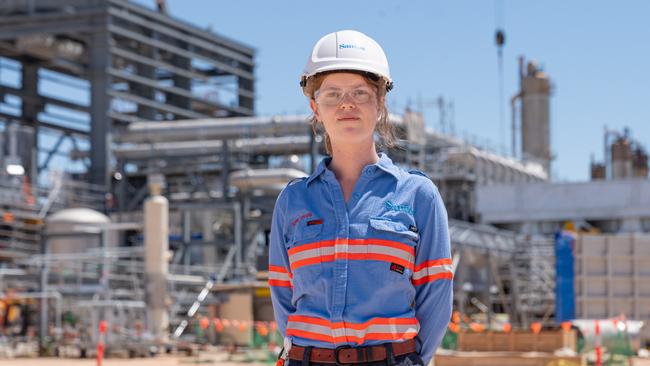Clean energy lies in store but court challenges risk investment, Santos boss says
Santos’ chief executive says the industry should focus on technologies that make using fossil fuels cleaner as the fuel source will be around for a long time.
SA News
Don't miss out on the headlines from SA News. Followed categories will be added to My News.
Fossil fuels will remain part of Australia’s energy mix for a long time, meaning technology such as carbon capture and storage is vital if the world wants to reach to net zero by 2050, according to Santos chief executive Kevin Gallagher.
At the same time, Mr Gallagher said overly complex legislation, too many “legal loopholes’’ and endless court challenges are risking much-needed investment in Australian resources projects.
But the Santos chief executive issued an upbeat assessment of CCS, which he said would provide a valuable economic opportunity for Santos and South Australia to help the transition to a carbon-free world and as new fuels such as hydrogen become a reality.
Mr Gallagher said it was a reality that the world would be using “fossil fuels for as long as we can imagine’’, which meant the real challenge would be removing carbon from the equation as a dangerous source of climate change.

“It would be almost impossible to achieve a net zero outcome without carbon capture and storage and the reason for that is there is no real future that doesn’t involve carbon of some sort,’’ he said.
“So you need a negative carbon technology to balance the carbon emissions that are going to come from (continuing to use fossil fuels).’’
It’s a view that has been previously backed by the International Energy Agency and former chief scientist Alan Finkel.
Last year, IEA executive director Fatih Birol confirmed CCS was a vital factor in achieving net zero.
“If we want to have these fossil fuels and at the same time reach our climate goals we have to use CCS,’’ Mr Birol said.
Likewise in an address to the Nation Press Club in 2020, Dr Finkel backed CCS as a vital part of the transition to a clean energy future.
Prime Minister Anthony Albanese is also a supporter of the technology, saying last year “carbon capture is one of the things that is available, and we know that with gas it is already effective”.

Mr Gallagher said Santos’s CCS facility, which will cost around $335 million, would be operating at its Moomba production facility from the third quarter of 2024.
Initially, it will capture carbon produced by its own operations, but in the longer term will market the service to other companies.
It has already signed memorandums of understanding with Sanjeev Gupta’s GFG to supply “abated’’ natural gas to the Whyalla steelworks. GFG could also become the first domestic customer for Santos's CCS project.
Agreements have also been signed with Japanese companies and the energy infrastructure business the APA Group.
Mr Gallagher has forecast that Santos will be able to store 1.7 million tonnes of CO2 when the Moomba facility is complete.
“I think that’s equivalent is something like 235,000 cars a year been taking off the roads in South Australia,’’ he said.
“So a very significant impact on South Australia’s annual emissions profile.’’
The carbon dioxide will be injected deep underground into the gas reservoirs that have been depleted through Santos gas extraction operations over its 70-year history.
The Santos chief executive said the answer to decarbonisation and achieving net zero lay in science.
He said science had helped solve previous environmental problems including the depletion of the ozone layer, acid rain and the damage caused by leaded fuel.
In the longer term, Mr Gallagher said Santos was developing carbon-neutral e-methane, which would be made using a combination of green hydrogen and carbon dioxide.
He said the advantage of e-methane was that it could replace natural gas and using the same pipeline infrastructure network Santos currently operates.
Santos is running a pilot project for e-methane but Mr Gallagher said it was a project that would not come to fruition until the 2030s.
Santos has also developed a ‘granite wash’ process that would allow it to extract gas at much greater depths than previously possible.
“We’re looking to develop that over the next couple of years and really, again, bring the Cooper Basin’s production up, maintain the operations while they’re there for another few decades to come,’’ he said.
However, Mr Gallagher also called for a “clarification of the requirements and simplification of the regulations and legislation’’ surrounding resources companies.
Santos has been involved in a number of legal battles, in January winning a Federal Court case, that allows it to start construction of its $5.8 billion Barossa gas project off the coast of the Northern Territory.
The company had previously been granted drilling rights by the National Offshore Petroleum Safety and Environmental Management Authority (Nopsema) but that had been delayed after a group of Tiwi Islander traditional owners lodged an objection.
However, that objected was dismissed by Justice Natalie Charlesworth, who also slammed the actions of the partially federally funded Environmental Defenders Office who represented the traditional owners, saying some of its evidence was “lacking integrity’’ and involved “confection’’.
Mr Gallagher declined to comment on the EDO but said companies had to be able to trust the regulatory process.

He said all approval processes required extensive consultation and he “had no problem’’ with that, but said once a regulator such as Nopsema made a decision then a company should be able to rely on it.
“Once we’ve done all of that … and we get our approval from the regulator … we make an investment decision, we commit billions of dollars … we need to know we’re not going to get stopped because there are loopholes through all the regulations,’’ he said.
“Otherwise, the risk is it becomes too difficult to invest in Australia.’’
Environment Minister Tanya Plibersek who is currently reviewing the actions of the EDO in the Santos case and said she expected “the Environmental Defenders Office to exhibit the highest ethical and professional standards’’.
“I have also asked the secretary of my department to review the allegations and advise me whether the EDO’s conduct is in accordance with their grant agreement.’’
A spokesperson for Resources Minister Madeleine King said the government was undertaking “a comprehensive review of Australia’s offshore environment and carbon management regulations’’.
Santos process engineer April Travis, who is working on Moomba CCS, said it was exciting to “be part of the team delivering this project.
“Being part of decarbonisation and emissions reduction was always a goal for me after I graduated,’’ she said.
“However, I never thought I would get to work on such a globally significant and large-scale project like Moomba CCS.’’



